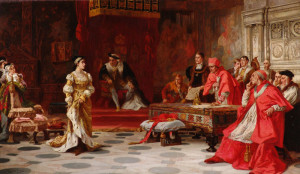Was she Catherine or Katherine? Confusing in any index, but in fact she was neither. In Spain she was baptised Catalina, not until after her first marriage in England did she call herself Katherine, or variations on that, but always with a K, and whenever monograms were used to embellish items of furniture, utensils, etc., always with a K.
It was no fault of Catherine’s that she became the centre of what was called, “The King’s Great Matter.” As already described, she was a pawn between her parents and Henry’s, although it was his elder brother Arthur whom she first married. She swore this marriage was never consummated, and since there was no such thing as privacy for persons of their rank it can reasonably be assumed it was not. Henry VII was under obligation to return her dowry if she were to go back to her parents in Spain, for him the better alternative was marriage to “the spare.” Though she was born in 1485, and Henry was born in 1491, they seemed genuinely fond of each other at the time of their marriage in 1509, and they were crowned together as King and Queen.
As the mother for the next sovereign, Catherine did her best to oblige: in 1510 her first born, a girl, was a stillbirth; in 1511 a son was born, christened Henry, and died 6 weeks later; in 1513 another son, but stillborn; in 1514 another son, christened Henry who died within the month; in 1516 her daughter Mary was born and lived to become Queen of England; in 1518 a daughter was born and died within the week. Academics discuss the problem, some suggest rhesus incompatibility (blood grouping), some suggest congenital syphilis as a result of Henry’s philandering. Doubtless there are many other suggestions, but no one knows whether there was a single specific problem, whether it was the mother or the father, and only in very recent years has it become acceptable even to consider the possibility of inadequacy in the male.
Henry and Catherine enjoyed intellectual companionship, they were both highly educated and literate for the times, both enjoyed music; Henry was also very “physical” in his nature, had a passion for hunting, other ball games, and as was usual then (and now) sovereigns were rather free with the women. In 1519 he fathered a son with a teenager, Elizabeth Blount, the boy was subsequently given many titles and offices and reportedly much loved by his father. Catherine, among others, was concerned that her husband would legitimize the young Henry Fitzroy, Duke of Richmond, and declare him heir to the throne. However, he died at the age of 17, probably of tuberculosis, and was never legitimized. The question of whether it was in fact tuberculosis raises the possibilities of familial genetic conditions that might have been responsible for the deaths of Henry VII, Henry Fitzroy, Edward VI and Catherine’s children.
Henry’s “Great Problem” was what to do? There was turmoil in Europe involving the major powers and the Pope. Henry’s claim to the throne was not strong, in fact genealogists could argue Catherine had a better claim through her ancestry, and without a strong sovereign England might be overwhelmed by her grasping neighbours. The issue is too involved and too long to deal with here, but it was not without significance that he was being led by the nose by Anne Boleyn whose sister Mary he had already enjoyed.
The upshot was, Henry disposed of Cardinal Wolsey who was not being helpful, Thomas Cromwell took over and did what was required (his eventual reward was decapitation), the marriage was annulled, Henry married Anne Boleyn, separated England from the Pope in Rome, declared himself head of the Church of England (but he was not a Protestant) and the English sovereign has held that position ever since.
Catherine was treated cruelly. She was allowed only to be recognized as the widow of Prince Arthur, her first husband, she was not allowed to see her daughter Mary. She was offered better treatment if she would recognize Anne Boleyn as Queen but refused to do so, and on her deathbed sent a loving letter to her husband. She was 50 years old when she died in January 1536.
There are no motifs of her name or initials in Hampton Court, but she did as Queen pay visits to Wolsey and did enjoy the state apartments he had created there.

